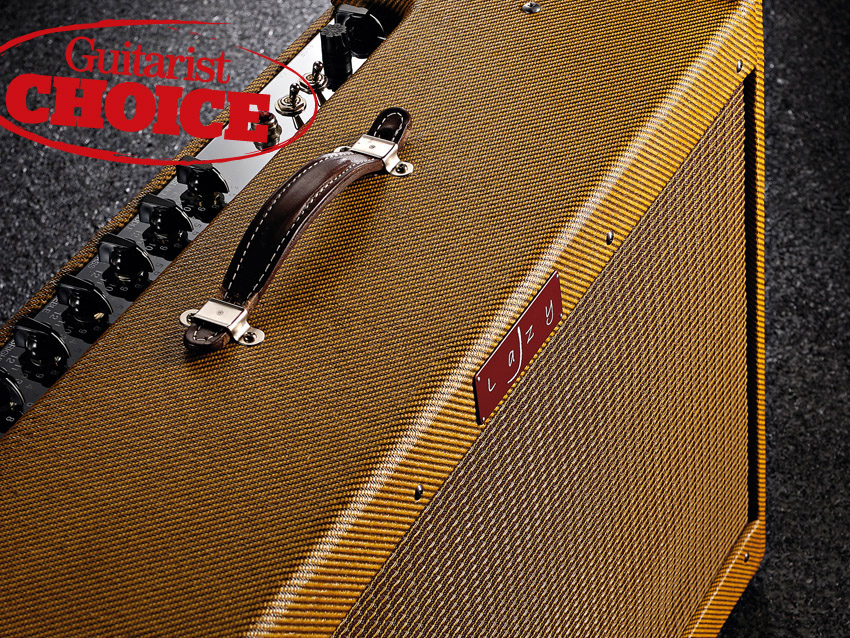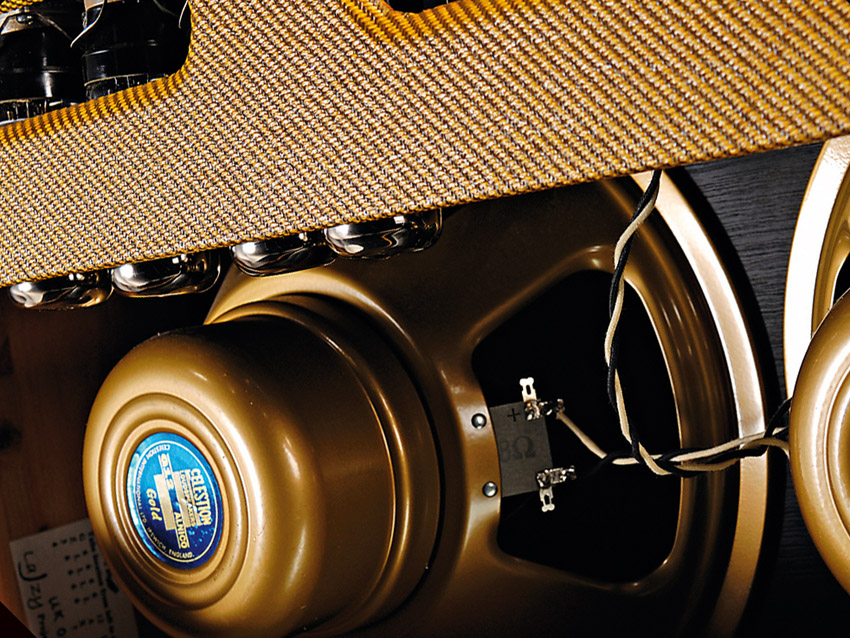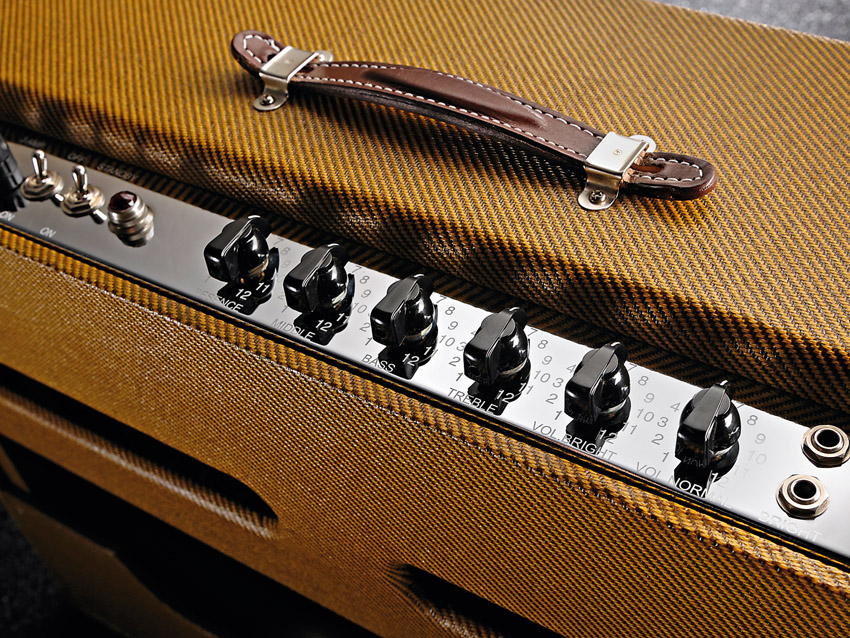MusicRadar Verdict
Lazy J's Model 80 combo is more than just a Tweed replica, its extra features really work. And then there's the sound…
Pros
- +
Superlative clean tone; built to last.
Cons
- -
It's quite a niche amp - not for everyone.
MusicRadar's got your back

Lazy J Model 80 Combo

Lazy J Model 80 Combo

Lazy J Model 80 Combo
While Fender's smaller Tweed amplifiers from the fifties - the Junior, Champ and Deluxe - have become some of the most highly prized collectables today, it's worth remembering that the Tweed era was also the genesis for, arguably, the most widely-used Fender amp of all time: the Twin.
For a while in the mid-to-late seventies - pre-digital effects and amp modelling of course - practically every recording studio and stage hire company in the world owned at least one Fender Twin Reverb combo, although when the Tweed Twin made its debut in the fifties, it lacked the now standard reverb.
If you ever wondered what one of these early amps would have sounded like with Laurens Hammond's other great invention, Lazy J may well have the answer in its new Model 80.
"Unlike many amps in this genre, the Lazy J 80 is biased toward producing big clean sounds at pro gig levels."
At first glance, the 80 appears to be a nicely-made replica of a fifties Twin Amp, with a handmade finger-jointed pine cabinet covered in thick, lacquered tweed. The chassis is chromed steel with white lettering and controls that go up to 12, in traditional Tweed style.
The electronics are quite close to the original 5F8 schematic, with all the small components mounted on an eyelet board - the traditional American way to build a guitar amplifier. The choice and positioning of components isn't accidental.
"Although my amps are inspired by old Tweed Fenders, I often make component changes, depending on the tone and response I'm going for," explains Jesse Hoff, the man behind Lazy J.
"These can be as small as changing a resistor type or as big as a new output transformer. For this particular project, we wanted to create an amp that was very loud and clean, but also fat and warm - two characteristics that don't always sit well together. The critical thing here was getting a good balance between preamp and power amp gain. It's about creating warmth and harmonics, without sacrificing the responsiveness".
The Model 80's standard of construction is very high indeed, with impeccable soldering and wiring, mostly using vintage Belden-style cloth-covered hook-up cable. The controls follow standard Tweed format, with two non-switching channels called bright and normal, each with a pair of inputs and separate volume controls, which can be jumpered together with a short patch lead.
Shared tone controls consist of bass, mid, treble and presence - and it's a true presence control, operating in the amp's negative feedback loop, unlike on some amps where the presence control is simply a high treble EQ centred around the 4kHz region. Incidentally, the original 1954 Twin was the first Fender amp to feature this control.
One extra chicken head knob next to the fuse carrier handles the 80's power fade function, which gradually adds or removes one pair of 6L6 power valves, varying the output from 40 to 80 watts.
Hoff's choice of loudspeaker for this review amp is Celestion's expansive and expensive Alnico Gold - one of a handful of drivers still fabricated in the UK. There's also an optional valve-powered Accutronics reverb spring, driven by a separate module mounted on the side wall of the cabinet, with two more 12AX7 valves and controls for reverb level and tone.

"I also offer an optional tremolo module" Hoff adds. "It's identical to the tremolo circuit I fitted to one of Eric Clapton's Twins a while back. Also, because both modules are mounted in the back of the amp, there's a cool stock modification to make the controls accessible: when the footswitch is plugged into the modules, the reverb intensity and tremolo speed can be adjusted by controls mounted on the footswitch itself."
Sounds
Unlike many amps in this genre, the Lazy J 80 is biased toward producing big clean sounds at professional gig levels, which means it's loud. The maximum output is 80 watts, which you might think is relatively modest by today's standards, but this amp really shifts the air. Imagine the revelation the original Tweed Twin must have been for players struggling with five, 10 or 15 watts back in the fifties.
However, if you're thinking clean as in cold and clunky, think again. The 80 is as sweet, warm and satisfying as honey on hot buttered toast. It's superbly responsive, with a medium-fast attack that's perfect for chicken picking and a very long natural sustain that clings to bent notes and flatters subtle vibrato use.
All this is enhanced by the superb valve reverb module, which has enough level and tonal range to suit any taste, going from crashy surf excess to a fat, dark halo that sounds more like a very expensive studio effect.
The 80 is equally happy with single coils or humbuckers, though a really dark mid-range biased humbucker won't produce enough high-end to make the speakers work properly.
The treble response when used with our regular Strat was simply breathtaking, with exceptional articulation and none of the rogue high frequency peaks that often afflict clean channels.
As you turn up the volume, there's a wonderful chiming effect that adds extra punch to chords without spoiling the note definition; even when the amp is overdriving properly with everything on 12, you can still hear every string.
The power amp fade control helps to dial-in this magic at higher or lower volume levels, although at 40 watts with one pair of 6L6's completely dialled-out, it's still very loud.
"If you push it really hard the amp goes into a thick crunch, without sacrificing its headroom. Some players prefer to get their drive sounds from pedals and this amp is ideally suited for that," says Hoff.
"However, recently I've added a push/pull switch that increases the gain in the second preamp and gives the amp quite a bit more drive if desired. This exact chassis was recently on tour with Public Image Ltd and has also been used in the studio by Razorlight and Richard Ashcroft. I'm also making another one for PiL to use for their US tour."

Some of the world's greatest players have instantly recognisable signature tones based on huge clean sounds. The Model 80 delivers the full gamut of Tweed tone - clean and overdriven - but clarity is where this amp really excels.
Especially well suited for country pickers and pedal or lap steel users, it's a big stage amp for professional players. It's not best suited to home use, but put it in the environment it was designed for and it will come alive.
The quality of tone and build is exceptional, something that's clearly winning Hoff plenty of friends, with recent customers including Noel Gallagher, PiL's Lu Edmonds, Pete Townshend and Doyle Bramhall II.
It's not cheap, but as a true boutique amp with real American mojo, but made in the UK. It's very good value too - if it came from the USA you could easily add another thousand to the asking price.
“Every one of them said yes without hesitation": Hank Marvin and Roger Taylor have just remade a '60s classic for charity
Do you know where your money goes when you buy a gig ticket? A new report breaks it down
“Every note counts and fits perfectly”: Kirk Hammett names his best Metallica solo – and no, it’s not One or Master Of Puppets









